- Top Employee Onboarding Software
- Why Use Employee Onboarding Software?
- Key Features of Effective Onboarding Software
- How To Choose The Right Onboarding Software?
- Which is the Best Onboarding Software?
- Frequently Asked Questions (FAQs)
- What Is Upskill And Reskill?
- Difference Between Reskilling And Upskilling
- Upskilling for Workplace Advancement
- Reskilling for Career Transformation
- Crafting Successful Upskill and Reskill Strategies
- Upskill And Reskill Strategizing: Things to Keep in Mind
- Measuring the Impact of Skill Development Initiatives
- Frequently Asked Questions
- What’s a Skill Gap?
- Employee Skill Gap Analysis: Why Do We Need It?
- How To Conduct Employee Skill Gap Analysis?
- Addressing Skill Gaps Through Training and Hiring
- Utilizing Skills Gap Analysis for Strategic Planning
- Leveraging Employee Skill Gap Analysis: Things To Keep In Mind
- Frequently Asked Questions
- Transformative Role of AI in Talent Acquisition
- Impact of AI on Business Recruiting
- Overcoming Challenges in AI-Driven Talent Acquisition
- Starting with AI in Talent Acquisition
- Future Landscape of AI in Talent Acquisition
- Frequently Asked Questions
- HR In The Hot Seat - Challenges With Evolving Workforce
- Mastering Effective HR Management: Tips For Overcoming Challenges
- Summing Up
- The Future of HR: Key Trends for 2024
- Skill-Based Hiring
- Prioritizing Employee Experience, Engagement & Well-being
- AI-Empowered Workforce Evolution and Its Impact
- Taking Diversity, Equity, and Inclusion Beyond Mandates
- Hybrid and Remote Work
- Embracing the Gig Economy and Blended Workforce
- Transparent HR Practices
- Climate Change Adaptation in HR Practices
- Leveraging HR Analytics for Data-Driven Decisions
- Continuous Learning & Development to Improve Productivity
- The Office Buzz in 2024
- Bottom Line - HR Operating Model Needs A Shift
- Importance and Impact of Recognizing Employee Birthdays
- Professional Birthday Wishes for Employees (All Experience Levels)
- Personalized Birthday Wishes for Employees in Different Roles
- Fun Birthday Wishes for Employees (with Templates)
- Birthday Wishes for Remote Employees
- Heartfelt Birthday Wishes for Employees
- Belated Birthday Wishes for Employees
- Simple & Sweet Birthday Wishes for Employees
- Celebrating Employee Birthdays: Ideas and Traditions
- Tips and Ideas for Sending Birthday Wishes to Employees
- Closing Thoughts
- Frequently Asked Questions
- What Is An Employee Referral?
- Benefits of Implementing Employee Referral Programs
- Setting Up an Effective Employee Referral Program
- Employee Referral Email
- Employee Referral Scheme
- Overcoming Challenges of Employee Referrals
- Companies with Best Employee Referral Programs
- Employee Referral Programs: Best Practices
- Closing Thoughts
- Frequently Asked Questions (FAQs)
- Importance of Team Building Activities
- Types of Team Building Activities
- Outdoor Team Building Activities for Employees
- Indoor Team Building Activities for Employees
- Easy Team Building Activities for Remote Employees
- Team Building Activities For New Employees (Icebreakers)
- Fun Team Building Activities for Different Goals
- To Boost Communication and Collaboration
- To Reduce Stress Levels and Promote Well-being
- Aligning Team Purpose and Values with Strategic Activities
- Final Remarks
- Frequently Asked Questions
- Importance of Employee Appreciation Quotes
- Work Appreciation Quotes for Employees
- Employee Appreciation Quotes for Hard Work Recognition
- Employee Appreciation Quotes for Teamwork and Collaboration
- Appreciation Quotes for Celebrating Employee Anniversaries and Milestones
- Employee Appreciation Quotes for Strong Work Ethics
- Employee Appreciation Quotes for Project & Goal Completion
- Employee Appreciation Quotes for Quality of Work
- Employee Appreciation Quotes for Creativity and Innovation
- Appreciation Quotes for Managers
- Peer-to-Peer Employee Appreciation Quotes
- Appreciation Quotes for Employees Leaving the Company
- Employee Appreciation Quotes for Thoughtful Gestures
- Funny Employee Appreciation Quotes
- Short Employee Appreciation Quotes
- Employee Appreciation Quotes for Different Roles
- Employee Appreciation Quotes for Senior Leadership
- Creative Ways to Use Employee Appreciation Quotes
- Summary
- Frequently Asked Questions (FAQs)
- What is Employee Satisfaction?
- Importance of Employee Satisfaction
- Objectives of Employee Satisfaction
- Employee Satisfaction vs. Employee Engagement
- Key Reasons for Employee Dissatisfaction
- Strategies for Improving Employee Satisfaction
- Ways to Measure Employee Satisfaction
- Best Practices for High Employee Satisfaction
- Final Remarks
- Frequently Asked Questions (FAQs)
- How to Craft Effective Employee Appraisal Comments
- Key Areas to Focus in Performance Review
- Comments On Hard Work & Dedication
- Assessing Interpersonal Skills
- Evaluating the Ability to Collaborate & Work in Teams
- Gauging Punctuality
- Commenting on Communication Style
- Reviewing Time Management and Productivity
- Leadership in Performance Appraisals
- Assessing Creativity & Innovation
- Evaluating Problem-Solving Abilities
- Recognizing Flexibility and Dependability in Reviews
- Employee Appraisal Comments for Different Roles
- Summary
- Frequently Asked Questions (FAQs)
- Employee Grievance Meaning
- Importance of Employee Grievance Process
- Types of Workplace Grievances
- Reasons for Employee Grievances
- Employee Grievance Procedure
- Steps in the Employee Grievance Handling Process
- Employee Grievance Form Example
- Final Remarks
- Frequently Asked Questions (FAQs)
- What is Company Culture?
- Importance of Company Culture
- Types of Company Culture
- Factors Contributing to Organizational Culture
- Assessing & Developing Corporate Culture
- Company Culture - It’s not just Perks or Feels
- Good Company Culture Examples
- Developing Company Culture: Best Practices
- Closing Thoughts
- Frequently Asked Questions (FAQs)
- What is Employee Empowerment?
- Benefits of Empowering Employees
- Employee Empowerment vs. Micromanagement
- Strategies for Effective Employee Empowerment
- Role of Managers in Fostering Empowerment
- Organizational Structure Supporting Empowerment
- Overcoming Barriers to Employee Empowerment
- Frequently Asked Questions (FAQs)
- What is Employer Branding?
- Importance of Employer Branding Strategy
- How to Build an Employer Branding Strategy?
- Strategies for Building a Strong Employer Brand
- How to Measure and Boost Your Employer Branding Success?
- Examples of Strong Employer Brand Strategy
- Best Practices for an Effective Employer Branding Strategy
- Closing Thoughts
- Frequently Asked Questions (FAQs)
- What are Employee Wellness Programs?
- Importance of Employee Wellness Programs
- Examples of Employee Wellness Programs
- Real-Life Examples of Corporate Wellness Programs
- Strategies for Encouraging Participation
- Supporting Diverse Employee Needs
- Creating Comprehensive Wellness Programs
- Measuring the Impact on Business and Employees
- Closing Thoughts
- Frequently Asked Questions (FAQs)
- What is Talent Management?
- Developing a Winning Talent Management Strategy
- Models and Frameworks
- Tips for Framing Effective Talent Management Strategy
- Looking Ahead: Recent Trends in Talent Management
- Frequently Asked Questions
- Role of AI in HR: Addressing Common Challenges
- Artificial Intelligence in HR Processes
- AI Tools for HR Functions
- How to Adopt AI in HR?
- Addressing Challenges of AI in HR
- Ethical and Responsible AI Use
- The Future of AI in HR
- Closing Thoughts
- Frequently Asked Questions
- What is Performance Management?
- Elements of Effective Performance Management
- Performance Management Cycle
- Differentiating Performance Management
- Benefits of Performance Management With Examples
- Challenges faced in Performance Management and their Solutions
- Future Trends in Performance Management
- Frequently Asked Questions
- Changing Role of HRM
- Changing Role Of HR Manager
- Technology and the Changing Role of HRM
- The Rise of AI and Machine Learning in HR
- Mobile Technology's Impact on HR Practices
- The Significance of People Analytics in HR
- Navigating the Future of HR Technology
- Final Remarks
- Frequently Asked Questions
- Compensation Management Meaning
- Compensation Types
- Breaking Down The Compensation Management Process
- HR Software for Compensation Management
- Current Trends in Compensation Management
- Frequently Asked Questions
- Defining Flexible Work Arrangements
- Flexible Working: Advantages for Businesses
- Challenges of Flexible Work Arrangements
- Crafting Flexible Working Practices
- Types Of Flexible Work Arrangements
- Comparing Flexible Work Arrangements
- Real-Life Examples of Flexible Work Arrangements
- Final Remarks
- Frequently Asked Questions
- Conflict Resolution Meaning
- Conflict Origins
- Tried & Tested Conflict Resolution Strategies
- Methods of Conflict Management at Workplaces
- Conflict Resolution Strategies: Top Management Tips
- Summary
- Frequently Asked Questions
- Career Development Meaning
- Career Development Plan for Employees
- Career Development in HRM: Growth Ideas For Employees
- Issues in Career Development and Their Solutions
- Closing Thoughts
- Frequently Asked Questions
- Understanding Compensation
- Exploring Benefits
- Difference between Compensation and Benefits
- Compensation & Benefits Structure
- Final Remarks
- Frequently Asked Questions
- Defining Recruitment in HR Practices
- Exploring Talent Acquisition in HR
- Understanding Talent Acquisition vs Recruitment
- When to Recruit or Acquire Talent
- Talent Acquisition vs Recruitment: Responsibilities
- From Recruitment To Talent Acquisition
- Closing Thoughts
- Frequently Asked Questions
- Work Culture Meaning
- Types of Work Cultures
- Components of Culture
- Best Work Culture Examples Set By Top Companies
- Creating a Positive Work Culture
- Closing Thoughts
- Frequently Asked Questions
- Defining Learning vs Development
- Importance of Learning and Development
- L&D Activities for Employees
- Choosing the Right L&D Activities
- Crafting an Effective L&D Strategies
- Aligning L&D Strategy with Business Goals
- Designing Engaging Learning Journeys
- Learning and Development Process: KPIs
- ROI in Learning and Development
- Emerging Trends in L&D
- Closing Thoughts
- Frequently Asked Questions
- What Is Leadership Development?
- Key Skills for Leaders
- How To Develop Leadership Skills in Organizations?
- What Is A Leadership Development Program?
- How To Develop A Leadership Development Program?
- Example of A Leadership Development Plan
- Benefits of Leadership Development Training
- Frequently Asked Questions
- Defining Diversity Training
- Importance of Diversity Training
- What are the Types of Diversity?
- Types of Diversity Training Methods
- Diversity Training Activities
- Choosing A Diversity Training Program
- How to Implement Diversity Initiatives
- Best Diversity Training Programs (Real-Life Examples)
- Improving the Effectiveness of Diversity Training
- Tracking and Evaluating the Results of DE&I Training Efforts
- Essential Elements for Successful Diversity Training
- Closing Thoughts
- Frequently Asked Questions
- Defining Occupational Health & Safety
- Evolution of Workplace Health and Safety
- Identifying Common Workplace Hazards
- Global Impact on Occupational Health & Safety
- Managing Employee Health and Safety Risks
- Occupational Health and Safety Problems
- Future of Occupational Health and Safety
- Frequently Asked Questions
- Employee Orientation Defined
- Employee Onboarding Explained
- Orientation and Onboarding: Understanding the Difference
- Importance of Orientation and Onboarding
- Crafting Comprehensive Integration Strategies
- Quick Tips for Orientation and Onboarding
- Frequently Asked Questions
- What is HR Metrics?
- Importance of HR Metrics
- HR Metrics Examples in Recruitment
- HR Metrics Examples in Employee Retention
- HR Metrics Examples in Revenue
- Other Common HR Metrics
- Soft HR Metrics Example
- HR Metrics Formula
- Utilizing HR Metrics Effectively
- Future of HR Metrics
- Summary
- Frequently Asked Questions
- Defining Decision Making Process
- Key Concepts In Decision Making
- Decision Making & Problem Solving
- Tips For Improving Decision Making Skills
- Selected Practice Questions & Answers
- Conclusion
- Frequently Asked Questions (FAQs)
- A case(s) of miscommunication
- The devil is in the (resume) details
- One for the complaints!
- What is an Exit Interview?
- Benefits of Exit Interviews to an Organization
- How to Conduct Exit Interviews?
- Exit Interview: Sample Questions to Ask
- Overcoming Challenges of Exit Interviews
- Exit Interviews: Best Practices
- Closing Thoughts
- Frequently Asked Questions
- Technology in the Workplace
- Benefits of Tech Integration
- Technology in the Workplace: Key Functions
- How Technology Normalized Remote Work
- Workplace Technology: Top Tools and Software
- Steps for Effective Technology Implementation
- Overcoming Tech Implementation Challenges
- Ethical Considerations in Tech Use
- Keeping Pace with Tech Trends
- Closing Thoughts
- Frequently Asked Questions
- What is Ethical Leadership?
- Principles of Ethical Leadership
- Difference between Ethics and Integrity
- Importance of Ethical Leadership
- Ethical Leadership in Practice
- Overcoming Challenges
- Frequently Asked Questions
- Embracing Change Management
- Mastering People Analytics
- Enhancing Stakeholder Relationships
- Navigating Diversity, Equity & Inclusion
- Upholding Ethics and Data Privacy
- Developing Critical Thinking
- Advancing Negotiation Techniques
- Fostering Inter-departmental Collaboration
- Building Resilience in HR
- Frequently Asked Questions
- What is Mental Health?
- Benefits of a Mentally Healthy Workforce
- Prioritising Mental Health: Creating a Culture of Support
- Final Remarks
- Frequently Asked Questions
- Gen Z vs Millennials - What is the difference?
- Retain and Engage Gen Z Employees: Need and Strategies
- Strategies to Retain and Engage Gen Z Employees
- Rethinking Requirements
- Final Remarks
- Frequently Asked Questions
- Understanding Millennial Leadership Needs
- Key Leadership Skills for Millennials
- How To Develop Millennial Into Leaders
- Additional Strategies to Develop Leaders
- Learning Preferences of Millennials
- Benefits of Investing in Millennial Leaders
- Closing Thoughts
- Frequently Asked Questions
- Understanding Fluff
- Examples of Interview Fluff
- Identifying Interview Fluff
- Addressing Interview Fluff
- Seeing Through the Fluff
- Frequently Asked Questions
- What is the Gender Pay Gap?
- Is the Gender Pay Gap Real?
- Factors Affecting the Gender Pay Gap
- How Age Impacts Women’s Earnings
- The ‘Motherhood Penalty’
- Education's Role in Wage Differences
- Racial and Ethnic Disparities in Pay
- Closing the Gender Gap
- Frequently Asked Questions
- Top Weirdest Late-To-The-Office Excuses
- The Fine Art of Balancing Wit and Wisdom in HR
- Understanding Social Media Recruiting
- Crafting Your Social Media Recruitment Strategy
- Implementing Your Strategy Effectively
- Popular Platforms for Recruitment
- Navigating the Downsides of Social Media Recruiting
- Measuring Success and Adjusting Strategy
- Summary
- Frequently Asked Questions
- Who Is A High Potential (HIPO) Employee?
- Characteristics of A High Potential (HIPO) Employee
- High Potential Employee Identification
- Grooming High Potential Employees
- Why High Potential Employees Leave
- How Do You Retain High Potential Employees?
- High Potential Employee Development: Best Practices
- Closing Thoughts
- Frequently Asked Questions
- What is Digital Fluency?
- Why Digital Fluency Matters?
- Difference between Digital Literacy and Digital Fluency
- Key Components of Digital Fluency
- Achieving Digital Fluency
- Overcoming Challenges
- Future of Workforce Digital Fluency
- Frequently Asked Questions
- What is Loud Quitting?
- Pros and Cons of Loud Quitting
- Reasons Behind the Trend
- Analyzing the Impact
- How HR Can Navigate the Loud Quitting Uproar
- Preventive Strategies
- Closing Thoughts
- Frequently Asked Questions
- Defining Emotional Intelligence in HR
- Why Emotional Intelligence Matters for HR Leaders
- How To Build Emotional Intelligence in HR
- Integrating EQ into HR Practices
- Impact of EQ on Company Culture
- Emotional Intelligence in HR: Major Challenges
- Final Remarks
- Frequently Asked Questions
- Understanding Internal Job Posting
- Internal Job Posting: Pros and Cons
- The Internal Job Posting Process
- Writing Effective Ads for Internal Job Posting
- Strategies for Success of Internal Job Posting
- Summary
- Frequently Asked Questions
- Understanding Workplace Bias
- Common Types of Bias in HR
- Closing Thoughts
- Frequently Asked Questions
- What is a Dry Promotion?
- Dry Promotion: Pros and Cons for Companies
- Impact of Dry Promotion on Employee Retention
- Preventing Talent Loss After Dry Promotions
- Closing Thoughts
- Frequently Asked Questions
- What Is A Stay Interview?
- Importance Of Stay Interviews
- Benefits And Challenges Of Stay Interviews
- Planning And Conducting Stay Interviews
- Stay Interviews: 20 Sample Questions To Ask
- Best Practices For Effective Stay Interviews
- Summary
- Frequently Asked Questions
- Who Is A Boomerang Employee?
- Reasons For Returning
- Benefits Of Hiring Boomerang Employees
- Challenges Of Rehiring
- Interviewing Boomerang Candidates: Sample Questions
- Enhancing The Hiring Process
- Making Informed Decisions
- Final Remarks
- Frequently Asked Questions
- Talent Pipeline Meaning
- Significance of Talent Pipelines
- Advantages of a Talent Pipeline
- Building a Talent Pipeline
- Maintaining a Talent Pipeline
- Attracting Top Talent
- Implementing the Strategy
- Frequently Asked Questions
- What is Micromanagement?
- Recognizing Micromanagement
- Leadership versus Micromanagement
- Keeping Micromanagement in Check
- Beyond Micromanagement
- Summing Up
- Frequently Asked Questions
- Recognizing Signs Of A Bad Hire
- Understanding The Impact On Teams
- Dealing With A Bad Hire
- Preventing Future Bad Hires
- Closing Thoughts
- Frequently Asked Questions
- Defining Neurodiversity
- Importance of Neurodiversity in the Workplace
- Moving Towards Inclusive Environments
- Final Remarks
- Frequently Asked Questions
- Understanding the Generation Gap
- Multigenerational Workforce: Debunking Stereotypes
- Strategies for Bridging the Gap
- Benefits of a Multigenerational Workforce
- Final Remarks
- Frequently Asked Questions
- Defining Productivity Theatre: All Show, No Go
- 5 Key Drivers of Fake Productivity
- Solutions to Combat Productivity Theatre
- Summary
- Frequently Asked Questions
- Defining Grumpy Staying
- Why do Grumpy Stayers not Leave?
- Recognizing the Signs
- Exploring the Causes
- Understanding the Impact
- Addressing the Issue
- Taking Action: Addressing Grumpiness with Empathy
- After the Conversation
- When Grumpy Staying Continues
- Closing Thoughts
- Frequently Asked Questions
- The Rationale Behind Office Peacocking
- Impact on Company Culture
- Impact on Employees
- Case Studies: Examples of Office Peacocking
- The Downside: Potential Pitfalls of Office Peacocking
- Practical Tips for Implementing Office Peacocking
- Frequently Asked Questions
- 13 Common Mistakes Young Managers Make
- Strategies To Avoid Mistakes (Individual Growth)
- How Young Managers Can Boost Teamwork
- Learning From Errors
- Summary
- Frequently Asked Questions
- Understanding Great Regret - What causes the shift shock?
- Impact of Great Regret
- How can HR help make the situation better?
- Closing Thoughts
- Frequently Asked Questions
- Understanding the HR Budget
- Key Components of an HR Budget
- Preparing an HR Budget Step-by-Step
- Importance of HR Budgeting in Management
- Final Remarks
- Frequently Asked Questions
- What are Pre-Employment Assessments?
- Importance of Pre-Employment Testing
- Types of Pre-Employment Assessments
- 15 Tips for Creating Effective Pre-Employment Assessments
- Closing Thoughts
- Frequently Asked Questions
- Exploring the Productivity Paradox
- Understanding the Impact of Solow Paradox
- Productivity Paradox: Why it Matters for Recruiters & HRs
- Identifying Causes and Challenges
- Strategies for Enhancing Productivity
- AI & the Modern-Day Productivity Paradox
- Beyond Technology: Building a Productive Workforce
- Summary
- Frequently Asked Questions
- Understanding the Great Reshuffle 2.0
- Preparing Leaders for the Change
- HR’s Role in Handling Great Reshuffling 2.0
- The Way Ahead
- Frequently Asked Questions
- Definition Of Managerial Grid
- Managerial Grid Theory Explained
- Application Of Managerial Grid
- Criticisms And Limitations
- Evolution And Contemporary Perspectives
- Integrating Managerial Grid With Other Models
- Practical Steps For Implementing Managerial Grid
- Conclusion
- Frequently Asked Questions
- Understanding Skills Taxonomy
- Why do we Need Skills Taxonomy?
- Benefits of Skills Taxonomy
- Components of Skills Taxonomy
- Building a Skills Taxonomy: A Step-by-Step Guide
- Skill Taxonomies vs Intelligence Tools
- Closing Thoughts
- Frequently Asked Questions
- Definition Of Team Building
- Stages Of Team Development
- Top 10 Strategies For Effective Team Building
- Team Building Activities
- Best Practices For Effective Team Building
- Setting Team Building Objectives
- Challenges In Team Building
- Conclusion
- Frequently Asked Questions (FAQs)
- Defining Job Shadowing
- Unpacking the Benefits
- Setting Up the Experience
- Job Shadowing vs Internship
- Dos and Don'ts for HR Professionals
- Closing Thoughts
- Frequently Asked Questions
- Employee Journey Mapping: Meaning & Importance
- Stages of the Employee Journey
- Steps for Effective Mapping
- Employee Journey Map: Where does it begin?
- Employee Journey Map: Template
- Best Practices & Tips
- Summary
- Frequently Asked Questions
- Why are Performance Appraisals needed?
- Evolution of Performance Management
- Modern Performance Practices
- Benefits of Modern Performance Appraisals
- The Future
- Frequently Asked Questions
- Is Experience the Sole Indicator of Success?
- Why Hire Inexperienced Talent?: Key Advantages
- Skills to Look For in Inexperienced Talent
- Challenges and Considerations in Hiring Inexperienced Talent
- Final Remarks
- Frequently Asked Questions
- What is a Company Retreat?
- Company Retreat Ideas: Team-Building & Exploration
- Relaxation and Celebration
- Planning Your Retreat: Things to Keep in Mind
- Closing Thoughts
- Frequently Asked Questions
- Understanding HR Forecasting
- HR Forecasting Key Concepts
- Steps for Implementing HR Forecasting
- Common HR Forecasting Methods
- Closing Thoughts
- Frequently Asked Questions
- What is ESG?
- HR and ESG - Why Care?
- ESG in HR Strategy
- Challenges for HR
- Future of ESG in HR
- Frequently Asked Questions
- Defining the Great Betrayal
- Reasons for Its Spread
- Impact on Workers
- Impact on Corporations
- Rebuilding Trust & Valuing Employees
- Closing Thoughts
- Frequently Asked Questions
- Importance of Clear Expectations
- Setting Expectations Early
- Communicating Expectations Effectively
- Differentiating Expectations
- Reviewing and Adjusting Expectations
- Summing Up
- Frequently Asked Questions
- Understanding KRA Frameworks And Models
- KRAs vs KPAs and KPIs
- Monitoring and Tracking KRAs
- KRAs in Various Roles
- Impact of KRA Frameworks and Models on Organizational Success
- Frequently Asked Questions
- Where: The Place of Work
- When: The Time of Work
- How Much Work: Alternate Employment Models
- Who Does the Work: Intelligence
- Designing Organizations with the Four Dimensions of Work
- Summing Up
- Simplifying Processes: The Foundation of Efficiency
- Reducing Unnecessary Meetings: Reclaiming Valuable Time
- Building Strong Accountabilities: Ensuring Responsibility
- Role of HR in Addressing Inefficiencies
- Continuous Improvement: A Commitment to Excellence
- Leadership's Role in Driving Efficiency
- Conclusion: A Holistic Approach to Efficiency
- Understanding Financial Freedom
- Benefits of Empowering Employees Financially
- Empowering Employees Through Financial Literacy
- Financial Topics That Need Attention Based On Career Stage
- Summing Up
- Frequently Asked Questions
- Defining Employee Voice
- Benefits of Amplifying Employee Voice
- Strategies and Tools
- Encouraging Participation
- Closing Thoughts
- Frequently Asked Questions
- Appraisal Blues: Signs of Unhappy Employees
- Addressing Unhappiness Post-Appraisal
- Non-Monetary Solutions for Dissatisfied Employees
- Summing Up
- Frequently Asked Questions
- Women in the Middle Eastern Workforce
- Importance of DEIB
- Role of HR in Building Inclusive Workplaces for Women
- Measuring Inclusion Progress: Key Metrics
- Closing Thoughts
- Frequently Asked Questions
- Preparing for the Conversation
- Conducting the Conversation
- Best Practices for the Talk
- After the Conversation
- Helping Employees Grow
- Frequently Asked Questions
- Understanding HR Exhaustion
- Factors Leading To HR burnout
- Impact Of HR Burnout
- Strategies To Prevent And Manage HR Burnout
- Role Of Technology In Preventing Burnout
- Celebrating HR Successes
- Summary
- Frequently Asked Questions
- Common Mistakes When Hiring Young Talent
- Building Connections with Candidates
- Summary
- Frequently Asked Questions
- Walking a mile in the employee’s shoes
- Conducting Humane Layoffs
- Remote Layoffs Management
- Supporting Laid-off Workers
- Managing the Aftermath
- Wrapping Up
- Frequently Asked Questions
- Importance of Shortening Time-to-Hire
- Shortening Hiring Time: Pre-Application Stage
- Reducing Hiring Time: Application Stage
- Hacks to Shorten Hiring Time: Interview Stage
- Reducing Hiring Time: Offer Stage
- 5 Other Important Hacks & Strategies
- Final Remarks
- Frequently Asked Questions
Technology In The Workplace: Benefits, Challenges & Strategies
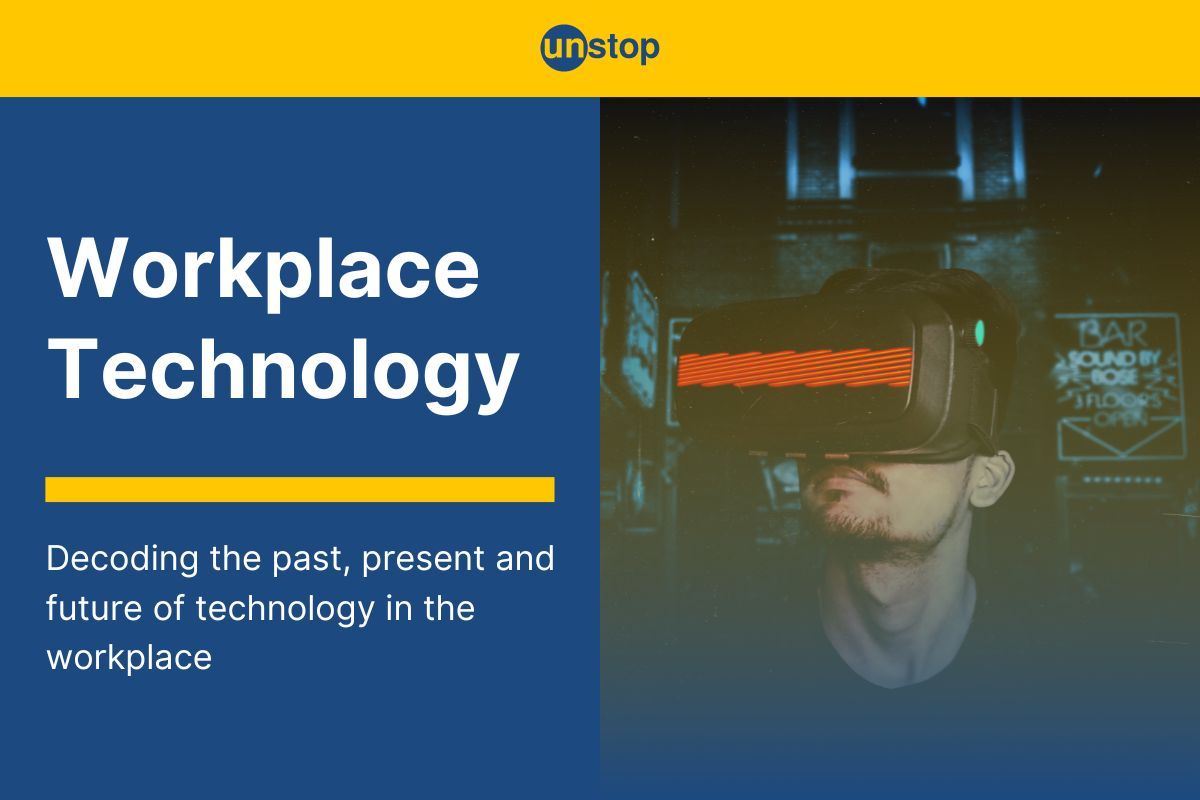
Technology in the workplace refers to the various tools, systems, and software used to enhance productivity, communication, and efficiency within an organization. This includes hardware such as computers, smartphones, and tablets, as well as software applications like project management tools, customer relationship management systems, and collaboration platforms.
The integration of technology in the workplace can streamline processes, improve decision-making, and facilitate remote work capabilities. By embracing technology, organizations can stay competitive, attract top talent, and create a more agile and innovative work environment.
Technology in the Workplace
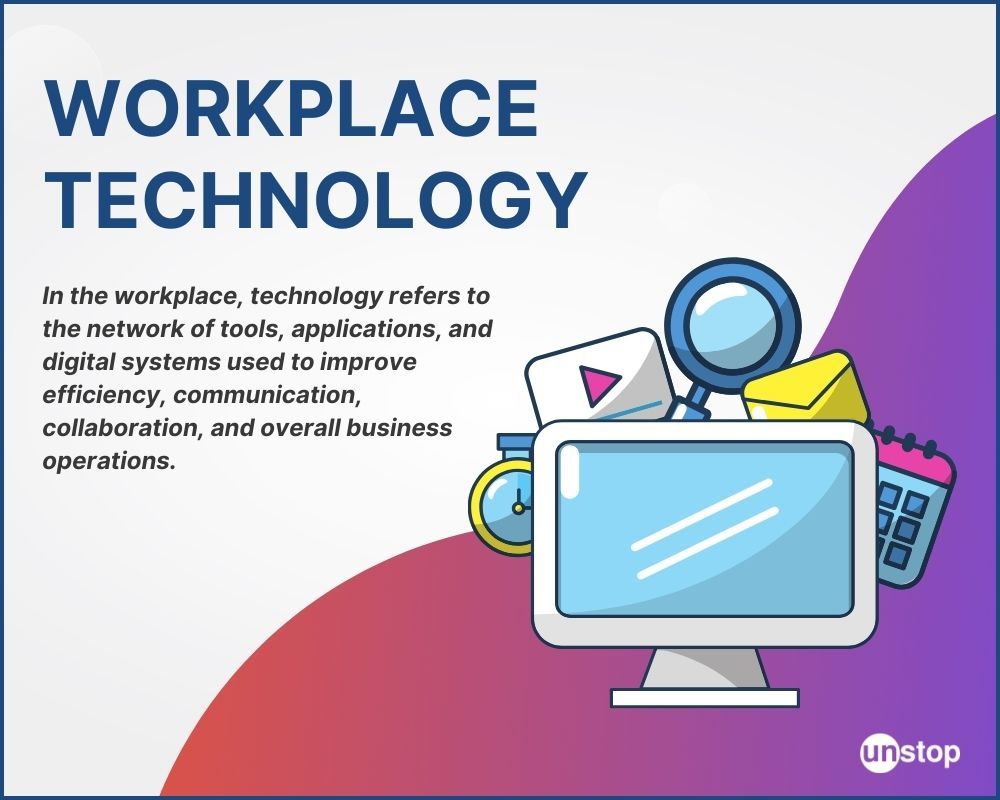
Technology in the workplace has significantly evolved over time, transforming the nature of work processes. The journey began in the early 20th century with the introduction of basic office equipment like typewriters and telephones. These tools revolutionized communication and documentation tasks, laying the foundation for future technological advancements. Today, work can take place on the go, literally, over tablets and mobile phones.
Key Milestones: From Typewriter To The Tablet
From the 1970s to the 1990s
The 1970s marked a crucial turning point in the use of technology in the workplace. The advent of personal computers ushered in a new era of digitalization. This innovation allowed for faster data processing, improved efficiency, and enhanced employee collaboration. Subsequently, the internet's widespread adoption in the 1990s changed workplace dynamics by enabling instant global communication and access to vast information resources.
From the 21st century
Technological advancements in the 2000s saw a significant shift towards digitalization and connectivity. The rise of smartphones, social media platforms, cloud computing, and e-commerce changed how we communicate, work, and conduct business.
When the pandemic hit in 2020, businesses were forced to adapt quickly to remote work environments. This accelerated the adoption of technology in the workplace as companies turned to video conferencing tools, project management software, and cloud-based solutions to stay connected and productive.
As a result, many companies saw the benefits of remote work and are now incorporating more flexible work arrangements even as we move beyond the pandemic.
Benefits of Tech Integration
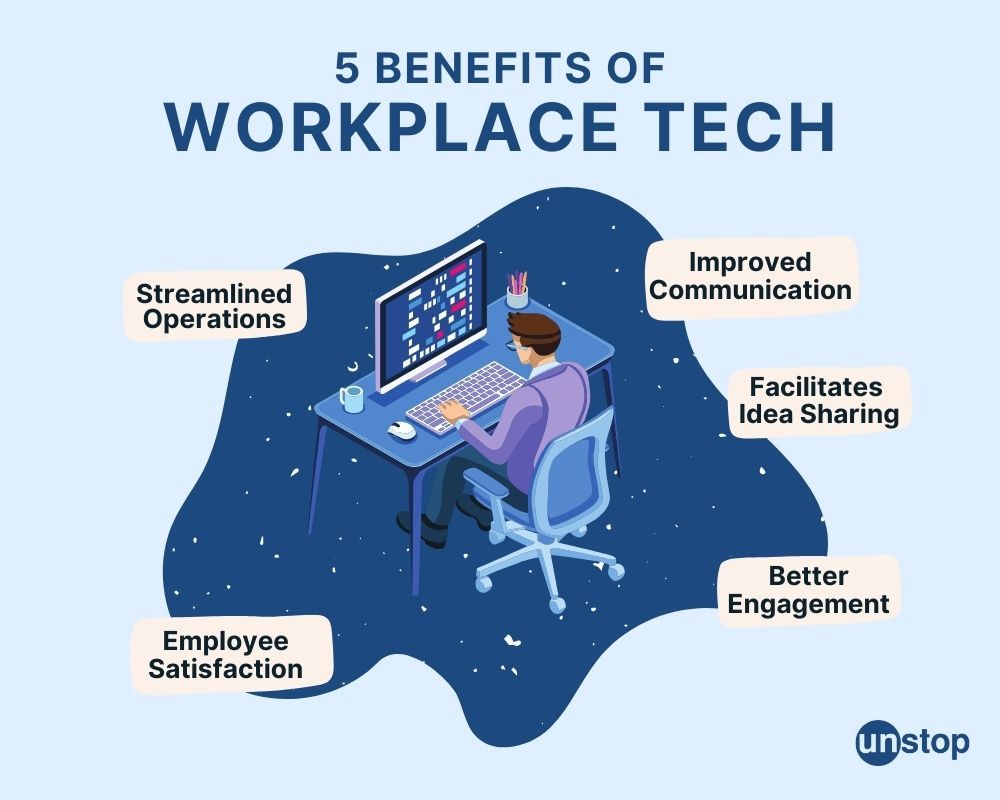
Streamlined Operations
Integrating technology in the workplace, especially into daily work routines, enhances efficiency by automating repetitive tasks and processes. This streamlining allows employees to focus on more critical aspects of their roles.
Technology integration reduces manual errors, ensuring accuracy in data entry, calculations, and reporting. By eliminating human errors, businesses can operate more smoothly and rely on precise information for decision-making.
Improved Employee Satisfaction
Adopting technology in the workplace leads to increased employee satisfaction through enhanced collaboration tools, flexible work arrangements, and improved communication channels. This offers much-needed flexibility to employees, enabling them to achieve a work-life balance.
Enhanced Engagement Levels
Technology integration fosters higher levels of employee engagement by providing opportunities for skill development through online training programs and resources. Digital platforms enable real-time feedback mechanisms, recognition systems, and gamification elements that motivate employees to perform at their best.
Fostering Communication
Technology plays a pivotal role in enhancing communication within organizations by providing various digital tools. These tools enable team members to connect instantly, whether they are working in the same office or remotely. With the help of technology, employees can share information, updates, and feedback efficiently.
Facilitating Idea Sharing
Collaborative platforms not only improve communication but also facilitate seamless idea-sharing among team members. Through these platforms, employees can collectively brainstorm ideas, provide inputs on different projects, and effectively collaborate on tasks. This leads to enhanced creativity and innovation within organizations.
Technology in the Workplace: Key Functions
Let’s take a look at some of the most common workplace functions that have been improved by technology:
- Recruitment: Technology streamlines the hiring process by automating applicant tracking and resume screening.
- Onboarding: Tech integration allows for digital onboarding processes, including e-signatures, online training modules, and virtual orientation sessions.
- Compensation and Performance Management: Technology enables real-time performance tracking, automated performance reviews, and data-driven compensation decisions, improving overall compensation management.
- Leave Management: Tech solutions simplify leave requests, approvals, and tracking, reducing administrative burden and ensuring compliance with company policies.
- Document and Work Management: Tech integration includes centralized storage, version control, and collaboration tools, streamlining workflows and ensuring document security.
- Data Analytics: Technology enables real-time data collection, analysis, and visualization, leading to informed decision-making and performance monitoring.
- Cybersecurity: Cybersecurity is bolstered by tech solutions that offer encryption, threat detection, and access controls, safeguarding sensitive information and preventing cyber threats.
How Technology Normalized Remote Work
The correlation between increased tech adoption and enhanced workplace output is evident in improved communication channels and enhanced efficiency. However, one of the biggest transformations through tech has been normalizing remote work.
Did you know? As of 2023, 28.2% of full-time employees work in a hybrid setting and 12.7% work from home.
Remote work has become increasingly prevalent in modern workplaces, allowing employees to work from anywhere with an internet connection. This shift has been facilitated by technological advancements, enabling seamless communication and collaboration regardless of physical location.
Companies now leverage tools like video conferencing, project management software, and cloud storage to support remote teams. These digital tools not only facilitate quick exchanges but also foster a sense of connectivity among colleagues who may be geographically dispersed.
With the rise of virtual collaboration platforms and shared documents stored on the cloud, teams can collaborate seamlessly on projects in real time without being confined to the same physical workspace.
The flexibility offered by remote work arrangements has proven beneficial for both employers and employees. Employers can tap into a global talent pool, reduce overhead costs associated with physical office spaces, and promote a better work-life balance for their staff.
On the other hand, employees enjoy greater autonomy over their schedules, reduced commute times, and increased productivity in a familiar environment.
Workplace Technology: Top Tools and Software
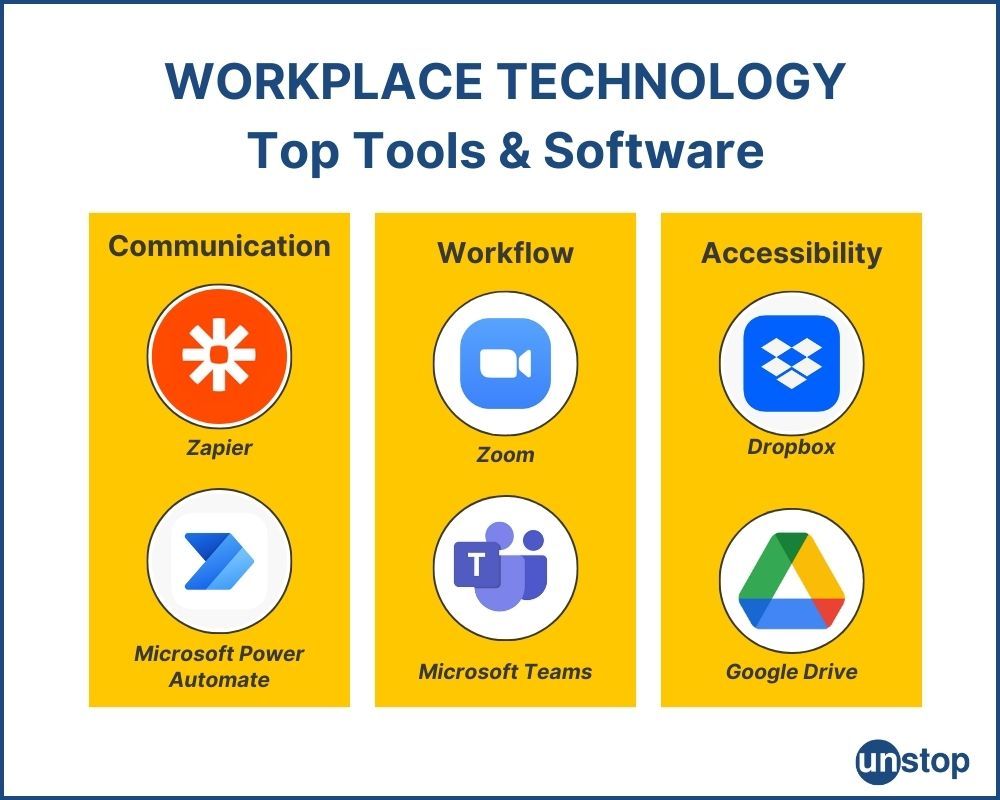
for Streamlined Workflow
Integrating project management software such as Trello or Asana facilitates task organization, collaboration, and deadline management. These platforms enhance team coordination, ensuring efficient project completion through clear communication channels.
Automation tools like Zapier or Microsoft Power Automate automate repetitive tasks, reducing manual workload and freeing up time for more critical responsibilities. By leveraging these tools effectively, companies can achieve higher levels of efficiency while minimizing errors in routine processes.
for Communication
Email remains a primary mode of communication; however, instant messaging platforms like Slack have gained popularity for real-time interactions among team members. Video conferencing tools such as Zoom or Microsoft Teams have replaced traditional face-to-face meetings.
These collaborative tools offer features like file sharing, app integration, etc. They create a virtual space where team members can interact in real-time, fostering better communication flow.
for Accessibility
Utilizing cloud-based storage solutions like Google Drive or Dropbox enables easy access to documents from anywhere at any time. This accessibility not only boosts efficiency but also supports remote work arrangements by providing a centralized repository for essential files.
Steps for Effective Technology Implementation
Creating a detailed digital intelligence strategy is crucial for seamless tech integration in the workplace. Here’s a step-by-step approach:
Developing Plans
Start by assessing current tech capabilities and identifying areas for improvement. Prioritize developing a roadmap that outlines specific goals, timelines, and key performance indicators to measure success. Engage employees at all levels to gather insights and ensure alignment with organizational objectives.
Selecting Technologies
When choosing technologies, consider factors such as scalability, compatibility with existing systems, and ease of integration. Conduct thorough research on available options to find solutions tailored to your business needs.
Evaluate the potential impact of each technology on daily operations and employee workflows. Seek input from relevant stakeholders to make informed decisions that support efficiency and productivity.
Deployment and Adoption
Successful deployment of new technologies requires effective communication, training, and support mechanisms. Develop a comprehensive rollout plan that includes training sessions, user guides, and ongoing assistance channels.
Encourage active participation from employees by highlighting the benefits of the new technologies in improving their work processes. Monitor adoption rates closely and address any challenges or resistance promptly to ensure smooth implementation.
Overcoming Tech Implementation Challenges
Tackling Resistance from Employees
When introducing a new technology stack, resistance from employees is a common challenge. To address this, organizations can foster open communication by encouraging feedback and involving staff in the decision-making process. Providing comprehensive training sessions can help alleviate fears and uncertainties.
Mitigating Disruptions
During the transition phase of tech implementation, it's crucial to mitigate potential disruptions to ensure business continuity. One approach is to conduct thorough risk assessments prior to deployment to identify possible bottlenecks or points of failure. Moreover, establishing contingency plans and allocating resources for troubleshooting can minimize downtime and operational hiccups.
Quick tip: Consider appointing change champions within different departments to facilitate smoother adoption and integration.
Balancing Digital Monitoring with Privacy Concerns
Privacy concerns related to technology in the workplace can also hinder its adoption. Employees may feel uneasy about the amount of personal data being collected and monitored by digital tools. Digital monitoring in the workplace can also be seen as intrusive and may lead to feelings of micromanagement among employees. This can impact morale and productivity.
To address this challenge, organizations can implement clear policies and procedures regarding data privacy, ensuring that employees' personal information is protected and used responsibly. Additionally, providing training and education on data security can help alleviate concerns and build trust among employees.
Building Workplace Relations
Technology can hinder the development of workplace relations by creating barriers to effective communication and fostering a sense of disconnection among employees. This may even lead to misunderstandings, a lack of trust, and a decrease in team cohesion.
One solution to this challenge is to encourage the use of video conferencing for meetings whenever possible. This allows employees to see each other's facial expressions and body language, which can help to build rapport and strengthen relationships. Additionally, incorporating virtual team-building activities can also help foster a sense of camaraderie and collaboration among colleagues.
By balancing the use of technology with opportunities for face-to-face interactions, organizations can overcome the obstacles that technology may pose to workplace relations.
Avoiding Over-Reliance on Technology
Over-reliance on technology may result in a lack of flexibility and adaptability in the face of unexpected disruptions. To address this challenge, organizations can promote a culture that values human connection and collaboration, encouraging employees to use technology as a tool to enhance their work rather than as a replacement for human interaction.
Ethical Considerations in Tech Use
Data Privacy
Data privacy remains one of the top concerns in today's technology-driven workplace. With increasing data breaches and cyber-attacks, safeguarding sensitive information is paramount. Organizations must prioritize implementing robust security measures to protect employee and customer data.
Establishing Guidelines
Establishing clear ethical guidelines for tech usage is crucial for fostering a culture of trust within organizations. By defining boundaries on data collection, storage, and usage, companies can ensure transparency and accountability in their technological practices. This not only safeguards sensitive information but also builds credibility with stakeholders.
AI Ethics
The rise of artificial intelligence (AI) raises significant ethical questions regarding bias, discrimination, and privacy invasion. Organizations need to navigate these challenges by incorporating ethical considerations into the development and deployment of AI systems. Ensuring fairness, transparency, and accountability in AI algorithms is imperative for responsible tech use.
Keeping Pace with Tech Trends
Future Work Technologies
In the digital age, staying updated on emerging tech trends is crucial for businesses to thrive. Technologies like artificial intelligence, blockchain, and the Internet of Things are reshaping the way we work. Adopting these technologies can improve various workplace processes.
For instance, AI-powered chatbots are transforming customer service by providing instant responses to queries. In healthcare, telemedicine solutions enable remote consultations and monitoring. Such advancements not only boost efficiency but also enhance user experiences.
Importance of Continuous Learning
To keep up with the rapid pace of technological advancements, employees must prioritize learning new skills regularly. Online platforms offer a plethora of courses ranging from data analytics to cybersecurity. Investing in continuous learning ensures that employees remain relevant in their roles and adaptable to changing job requirements.
Upskilling enhances an individual's value in the job market while benefiting organizations through improved performance and innovation capabilities. By embracing a culture of lifelong learning, companies foster a dynamic workforce capable of tackling challenges in today's fast-paced environment.
Strategies for Staying Updated
Staying ahead in the tech-driven workplace requires proactive measures such as attending industry conferences and webinars to gain insights into upcoming trends. Networking with professionals in the field can provide valuable perspectives on industry developments and potential opportunities for collaboration.
Moreover, subscribing to reputable news sources dedicated to technology updates keeps professionals informed about breakthroughs that could impact their respective industries positively.
Embracing Innovation Culture
Embracing an innovation culture is essential for businesses aiming to leverage technology effectively. Encouraging experimentation allows employees to explore creative solutions while promoting a mindset focused on problem-solving rather than maintaining the status quo.
Did you know? Studies on the Indian workforce indicate that women are more enthusiastic about embracing upskilling opportunities compared to their male counterparts in corporate and non-corporate sectors. While female executives at the C-suite level are willing to invest more than men in upskilling programs, 81% of the 13.8 lakh non-literate and neo-literate trained under Jan Shikshan Sansthan are women!
Closing Thoughts
Embracing tech strategies can transform the work environment, making it more productive and adaptable to changing trends. Overcoming implementation challenges and considering ethical implications are crucial steps in maximizing the advantages of technological integration.
Staying informed about the latest tech trends will further help companies stay ahead in this fast-paced digital era and create a dynamic and future-ready work environment that fosters innovation and growth.
Frequently Asked Questions
1. What is the role of technology in the workplace?
Technology plays a crucial role in the workplace by enhancing productivity, streamlining processes, facilitating communication and collaboration, enabling remote work, and driving innovation.
2. What are some common types of workplace technology?
Common types of workplace technology include computers, software applications (such as productivity suites, project management tools, and customer relationship management systems), communication tools (such as email, video conferencing, and instant messaging), hardware devices (such as smartphones, tablets, and wearable technology), and automation systems (such as robotic process automation and artificial intelligence).
3. How can technology improve productivity in the workplace?
Technology can improve productivity in the workplace by automating repetitive tasks, providing access to real-time data and information, enabling faster communication and collaboration, facilitating remote work and flexible scheduling, and supporting efficient project management and workflow optimization.
4. What are some cybersecurity best practices for employees?
Some cybersecurity best practices for employees include using strong, unique passwords for each account, enabling two-factor authentication where available, being cautious of phishing emails and suspicious links, keeping software and systems updated with the latest security patches, using secure networks when accessing sensitive information, and being mindful of data privacy and confidentiality.
5. How can employers ensure the successful implementation of new technology in the workplace?
Employers can ensure the successful implementation of new technology in the workplace by conducting thorough needs assessments and feasibility studies, involving employees in the decision-making process, providing comprehensive training and support, fostering a culture of innovation and adaptability, monitoring progress and soliciting feedback, and continuously evaluating and refining the technology to align with organizational goals and objectives.
Suggested Reads:
I’m a reader first and a writer second, constantly diving into the world of content. If I’m not writing or reading, I like watching movies and dreaming of a life by the beach.
Login to continue reading
And access exclusive content, personalized recommendations, and career-boosting opportunities.
Subscribe
to our newsletter
Blogs you need to hog!
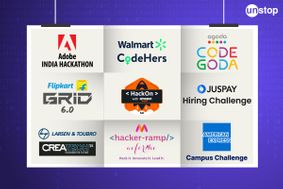
Organize Hackathons: The Ultimate Playbook With Past Case Studies

What is Campus Recruitment? How To Tap The Untapped Talent?

Lateral Hiring: A Complete Guide To The Process, Its Benefits, Challenges & Best Practices
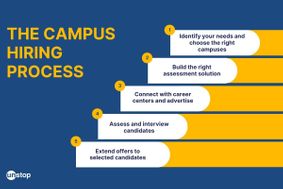








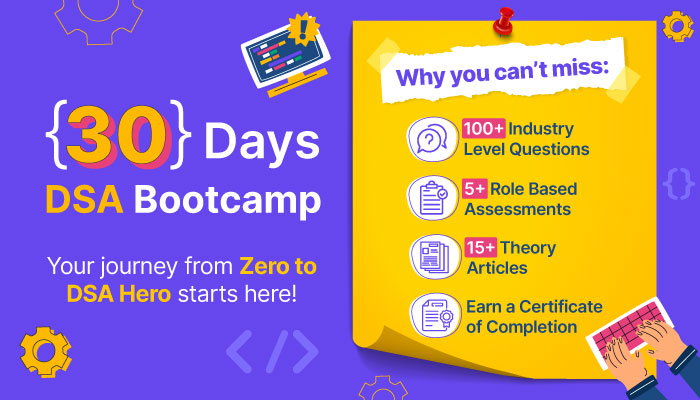


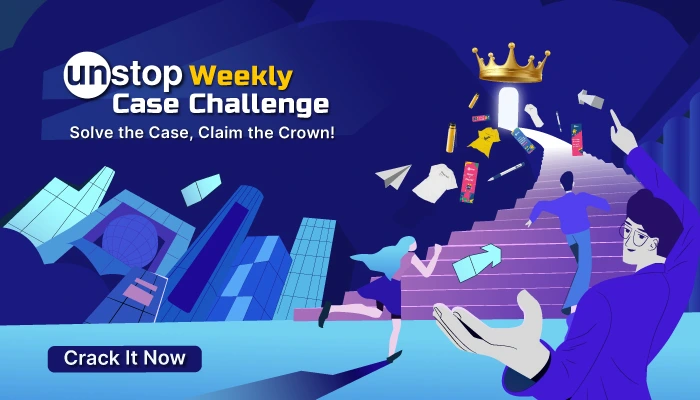
Comments
Add comment